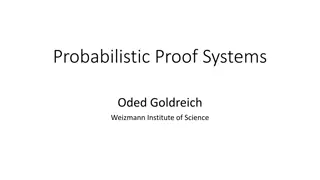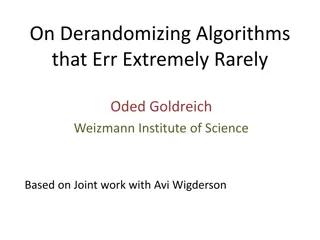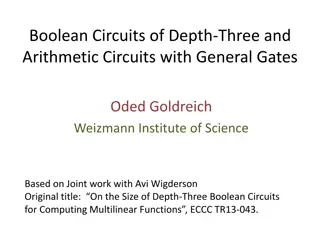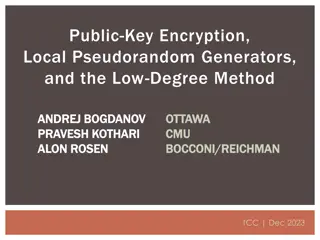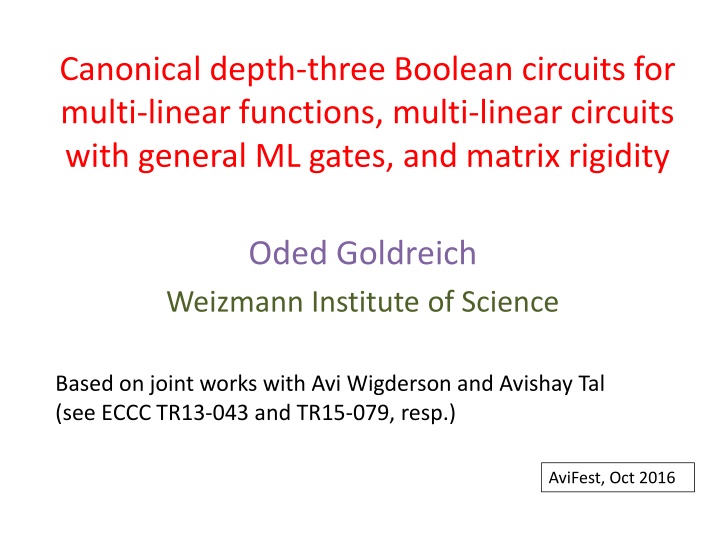
Canonical Depth-Three Boolean Circuits and Flight Trilogy Stories
Explore canonical depth-three Boolean circuits for multi-linear functions and entertaining flight trilogy stories involving Avi, Silvio, and Shafi as they navigate airport mishaps and miscommunications. An engaging blend of technical insights and humorous anecdotes.
Download Presentation

Please find below an Image/Link to download the presentation.
The content on the website is provided AS IS for your information and personal use only. It may not be sold, licensed, or shared on other websites without obtaining consent from the author. If you encounter any issues during the download, it is possible that the publisher has removed the file from their server.
You are allowed to download the files provided on this website for personal or commercial use, subject to the condition that they are used lawfully. All files are the property of their respective owners.
The content on the website is provided AS IS for your information and personal use only. It may not be sold, licensed, or shared on other websites without obtaining consent from the author.
E N D
Presentation Transcript
Canonical depth-three Boolean circuits for multi-linear functions, multi-linear circuits with general ML gates, and matrix rigidity Oded Goldreich Weizmann Institute of Science Based on joint works with Avi Wigderson and Avishay Tal (see ECCC TR13-043 and TR15-079, resp.) AviFest, Oct 2016
thanks To the organizers who usually hear only complaints and curses Also to the PC chair, even when papers are not accepted
A story that Avi hates the least (told in a more kind manner than usual) by Oded AviFest, Oct 2016
The Flight Trilogy: Avi In mid 1980s, Avi visited MIT for a week. On the last day: 11:30: I arrive at my office. Avi asks if I can bring him to Logan. I asked at what time is his flight. He says it is at 4pm, but he wants to be there at 2pm. I say it will take me 15 minutes to get to Logan. 11:40: Avi asks how long will it take us to get to Logan. I tell him again that 15 minutes will do. 11:45: He asks again, and I answer again. 11:50, 11:55, 12:00, 12:05, 12:10: Ditto. 12:15: Avi cannot be contained. I drive him to the airport. 12:30: at the airport a final exchange: Avi confesses that he was lying. His flight is at 7pm.
The Flight Trilogy: Silvio Some time (in late 1980s), in a caf , at the east coast of the Mediterranean (i.e., in Tel-Aviv). 11:30: I meet Silvio and ask at what time is his flight. He answers In the afternoon. 13:00: I ask again, and get the same answer. 14:00: I ask again, get the same answer again, but demand to see his flight ticket. 14:03: His flight is at 15:00 It is 45 min drive to airport. 14:35: Inspired by Silvio, we are at the airport. A security guy volunteers to rush Silvio to the gate.
The Flight Trilogy: Shafi Problem: Promised to give a talk in the morning of day D in some far-away university. Step 1: Make reservations to all (6-8) flights going out from Logan in day D-1. Step 2 (@ MIT): Realize it is < 2 hour to the last flight. Take the slides (i.e., all slides). Step 3: Dinner at Bertucci s. (Ends 1 hour to the flight) Step 4: Drive home, take clothes (i.e., all, almost). Step 5: Get to Logan, on time for the flight.
Canonical depth-three Boolean circuits for multi-linear functions, multi-linear circuits with general ML gates, and matrix rigidity Oded Goldreich Weizmann Institute of Science Based on joint works with Avi Wigderson and Avishay Tal (see ECCC TR13-043 and TR15-079, resp.)
Constant Depth Boolean Circuits Paritynrequires depth d circuits of size exp( (n1/(d-1))), and this is tight. Famous frontier: Stronger circuit models. Another frontier: Stronger lower bounds (i.e., exp( (n))). This will be our focus here. Suggestion 1: Consider multi-linear (e.g., bilinear) functions. Suggestion 2: Focus on depth three. Suggestion 3: Study a restricted class of (canonical) Boolean circuits, which corresponds to (ML) Arithmetic circuits with general (ML) gates. About the latter model: sanity checks, connection to matrix rigidity, an explicit trilinear function that is harder than parity.
Suggestion 1: Consider multilinear functions Recall: Depth d circuits for Paritynhave size exp( (n1/(d-1))). We seek Stronger lower bounds (i.e., exp( (n))). Multi-linear functions : x=(x(1), ,x(t)), x(i) 0,1 n F(x(1), ,x(t)) = (i_1, ,i_t) Txi_1(1) xi_t(t) associated with tensor T [n]t Think of t=2, log n The complexity of computing F is supposed to arise from the complexity of the tensor. Conj (sanity check): For every t>1, there exists a t-linear function that requires depth-three circuits of size exp( (tnt/(t+1))). [holds for t=1 ]
Suggestion 2: Focus on depth three Conj (1stsanity check): For every t>1, there exists a t-linear function that requires depth-three circuits of size exp( (tnt/(t+1))). [holds for t=1] Goal (assuming conj.): For every t>1, present an explicit t-linear function that requires depth-three circuits of size exp( (tnt/(t+1))). [holds for t=1] A 2ndsanity check: Consider a restricted model of (depth-three) circuits, and prove the L.B. in it. t-linear functions x=(x(1), ,x(t)), |x(i)|=n F(x(1), ,x(t)) = (i_1, ,i_t) Txi_1(1) xi_t(t)
Suggestion 3: Canonical Boolean circuits and MultiLinear circuits with general gates Recall (the 2ndsanity check): Consider a restricted model of (depth-three) circuits, and prove the L.B. in it. Motivation: the standard construction of depth-three circuit for n-way Parity. CNF of size exp(sqrt(n)). Parsqrt(n) . . . . . . . . Parsqrt(n) Parsqrt(n) sqrt(n) DNFs of size exp(sqrt(n)). In general, use arbitrary ML gates of bounded arity: A gate of arity is implemented by a CNF/DNF of size exp( ). A depth-two ML circuit with m such gates, yields a (canonical) depth-three Boolean circuit of size m exp( ).
Suggestion 3: Canonical Boolean circuits and MultiLinear circuits with general gates In general, use arbitrary ML gates of bounded arity: A gate of arity is implemented by a CNF/DNF of size exp( ). An ML circuit (of arbitrary depth) with m such gates, yields a (canonical) depth-three Boolean circuit of size exp(m+ ). Goal: For every t>1, present an explicit t-linear function that requires canonical (depth-three) circuits of size exp( (tnt/(t+1))). Def (AN-complexity): The complexity of a (ML) circuit (of arbitrary depth) with arbitrary ML gates equals the maximum between the arity of its gates and the number of gates. E.g., Parity has AN-complexity (sqrt(n)), and we wish to bypass this. Goal (restated): For every t>1, present an explicit t-linear function that require AN-complexity (tnt/(t+1)). (Holds for t=1.)
Are canonical Boolean circuits as powerful as general depth three circuits (wrt computing multilinear function)? Oded: I believe so. Avi: I don t know. In any case, it is begging to prove lower bounds for it (equiv. for AN-complexity): Firstly, because lower bounds on the size of depth-three circuits for ML functions require lower bounds on AN-complexity, and secondly because such lower bounds exist (i.e., hold for non-explicit functions) and are seemingly within reach.
On the AN-complexity of MultiLinear functions Thm1: For every t 1, every t-linear function has AN-complexity O(tnt/(t+1)). Via a circuit of depth 2. Thm2: For every t 1, almost all t-linear functions require AN-complexity (tnt/(t+1)). Thm3: Explicit 3-linear and 4-linear functions of AN-complexity (n0.6) and (n0.666), resp. Def (AN-complexity): The complexity of a circuit with arbitrary ML gates equals the maximum between the arity of its gates and the number of gates. Goal: For every t>1, present an explicit t-linear function that require AN-complexity (tnt/(t+1)).
t-linear functions x=(x(1),,x(t)), |x(i)|=n F(x(1), ,x(t)) = (i_1, ,i_t) Txi_1(1) xi_t(t) Proofs of Thm 1&2 Thm1: For every t 1, every t-linear function has AN-complexity O(tnt/(t+1)). Decompose the tensor T into m=O(tnt/(t+1)) sub-tensors each having side of length nt/(t+1). Compute each tensor by a single gate of arity m, and use a top gate to compute their sum. Thm2: For every t 1, almost all t-linear functions require AN-complexity (tnt/(t+1)). A counting argument: The number of t-ML circuits of AN- complexity m is dominated by (exp(mt))m=mt+1. Def (AN-complexity): The complexity of a circuit with arbitrary ML gates equals the maximum between the arity of its gates and the number of gates.
t-linear functions x=(x(1),,x(t)), |x(i)|=n F(x(1), ,x(t)) = (i_1, ,i_t) Txi_1(1) xi_t(t) Proof of Thm 3 Thm3: Explicit 3-linear and 4-linear functions of AN-complexity (n0.6) and (n0.666), resp. Super Structured Lem3.1: If a bilinear function has AN-complexity m, then the corresponding matrix does not have (ss)-rigidity m3for rank m. Lem3.2: A random Toeplitz matrix M has rigidity (n1.8) for rank n0.6. Use F(x,y) = (i,j) Txiyj= i,jMi,jxiyj Lem3.3: A pseudorandom matrix M has ss-rigidity (n1.999) for rank n0.666. Use F(x,y) = i,jMi,jxiyjfor a bilinear form M. Def (AN-complexity): The complexity of a circuit with arbitrary ML gates equals the maximum between the arity of its gates and the number of gates. Goal: For every t>1, present an explicit t-linear function that require AN-complexity (tnt/(t+1)).
AN-complexity of 2-linear fnc and matrix rigidity Lem3.1: If a bilinear function has AN-complexity m, then the corresponding matrix does not have (super-structured) rigidity m3for rank m. Lem3.2: A random Toeplitz matrix M has rigidity (n1.8) for rank n0.6. Use F(x,y) = (i,j) Txiyj= i,jMi,jxiyj Lem3.3: A pseudorandom matrix M has super-structured rigidity (n1.999) for rank n0.666. Use F(x,y) = i,jMi,jxiyjfor a bilinear form M. Def1: A matrix M does not have rigidity s for rank r if M=S+R such that S has at most s ones (is s-sparse) and R has rank r. Def2: M does not have structured rigidity s for rank r if M=S+R as in Def1 with the ones of S residing in s rectangles of side-length s. Def3: M does not have super-structured rigidity s for rank r if M=S+R as in Def2 such that R is spanned by s-sparse rows and columns. Def: The AN-complexity of a circuit with arbitrary ML gates equals the maximum between the arity of its gates and the number of gates. Note: SS-rigidity is equivalent to AN-complexity t-linear functions x=(x(1), ,x(t)), |x(i)|=n F(x(1), ,x(t)) = (i_1, ,i_t) Txi_1(1) xi_t(t)
The notions of (matrix) rigidity Def1: A matrix M does not have rigidity s for rank r if M=S+R such that S has at most s ones (is s-sparse) and R has rank r. Def2: M does not have structured rigidity s for rank r if M=S+R as in Def1 with the ones of S residing in s rectangles of side-length s. Def3: M does not have super-structured rigidity s for rank r if M=S+R as in Def2 such that R is spanned by s-sparse rows and columns. Def1: non-rigid = sparse + low-rank. Def2: non-structured rigidity = structured-sparse + low-rank, where structure-sparse = sum of few matrices such that in each matrix the 1 s are confined to small rectangles. Def3: non-super-structured rigidity = structured-sparse + low-rank- spanned-by-sparse-row + low-rank-spanned-by-sparse-columns. Def: The AN-complexity of a circuit with arbitrary ML gates equals the maximum between the arity of its gates and the number of gates. Note: Super-Structured-rigidity is equivalent to AN-complexity
Def (AN-complexity): The complexity of a circuit with arbitrary ML gates equals the maximum between the arity of its gates and the number of gates. Open problems Thm3: Explicit 3-linear and 4-linear functions of AN-complexity (n0.6) and (n0.666), resp. Goal: For every t>1, present an explicit t-linear function that require AN-complexity (tnt/(t+1)). Open problem: Explicit 2-linear functions of AN-complexity (n0.51), then (n0.666). Probably w.o. using the rigidity connection Open problem: Explicit O(1)-linear functions of AN-complexity (n0.667). Then, (n0.999). Conj (1stsanity check): For every t>1, there exists a t-linear function that requires depth-three circuits of size exp( (tnt/(t+1))). [holds for t=1]
END Slides available at http://www.wisdom.weizmann.ac.il/~oded/T/avi-kk.pptx Papers available at http://www.wisdom.weizmann.ac.il/~oded/p_kk.html http://www.wisdom.weizmann.ac.il/~oded/p_rigid.html

